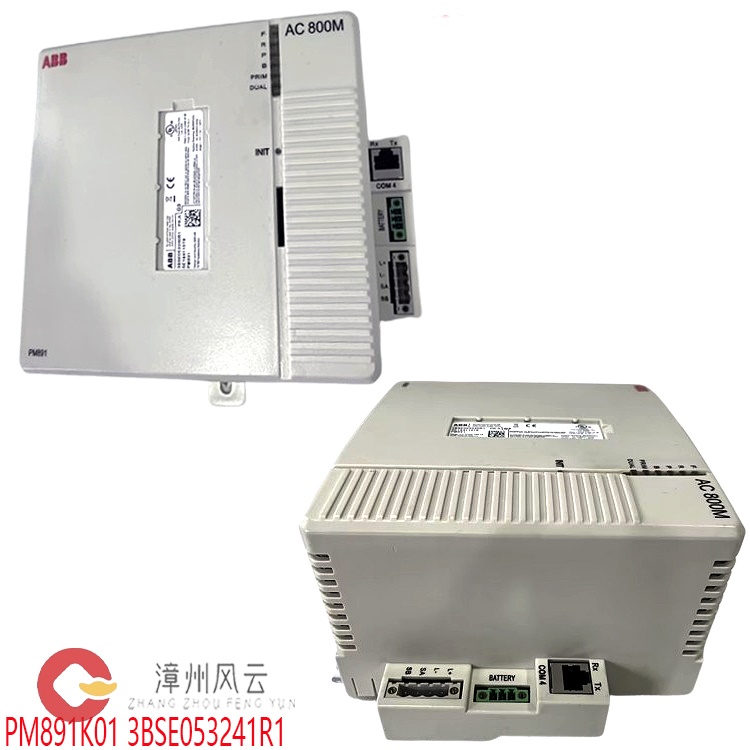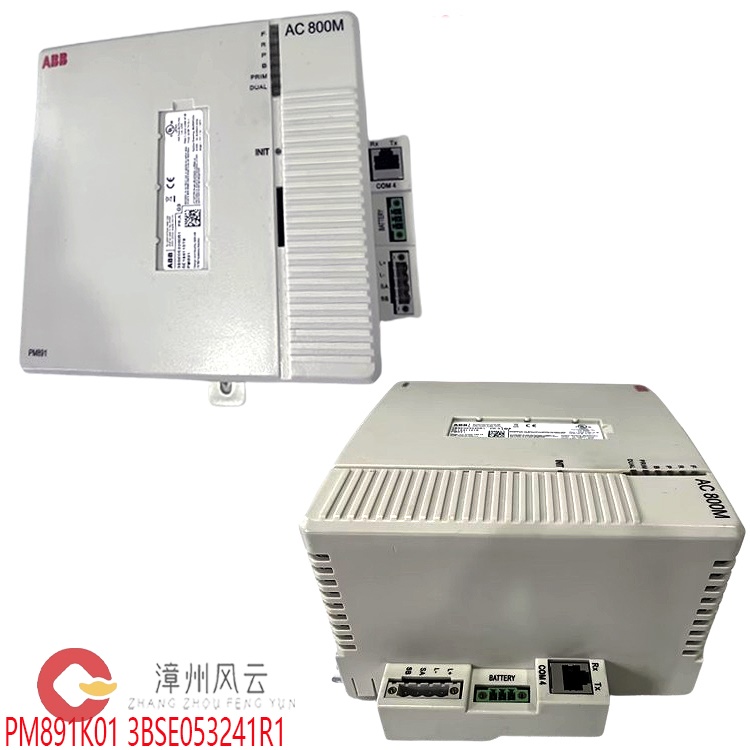
.jpg)
.jpg)

.jpg)
.jpg)
Using ABB's Control Builder M software, it supports the IEC 61131-3 standard (ladder diagram, function block diagram, structured text, etc.), is based on 32-bit or 64-bit processors, supports real-time control tasks, and two controllers (main/standby) run synchronously. When the main controller fails, the standby controller switches seamlessly without interruption. The built-in self-diagnosis function can detect hardware failures, communication interruptions or software errors, and trigger alarms or redundancy switching.
Many products are not yet on the shelves. Please contact us for more products.
If the product model is inconsistent with the display picture, the model shall prevail. Please contact us for specific product pictures, and we will arrange to take photos in the warehouse for confirmation.
We have 76 shared warehouses around the world, so sometimes it may take several hours to accurately return to you, please understand. Of course, we will respond to your concerns as soon as possible.
PM891 3BSE053240R1 Other names:
Redundant communication unit PM891 3BSE053240R1
PM891 3BSE053240R1 Redundant processor
Redundant communication unit PM891 3BSE053240R1
Product Overview
Model: PM891 3BSE053240R1
Brand: ABB (a global leading industrial automation and power technology company)
Series: AC800M (ABB's modular controller series, suitable for medium and large industrial automation projects)
Function: Redundant system control unit, providing high availability and fault tolerance to ensure continuous operation of industrial processes.
AC800M Series Features
Modular design: supports flexible configuration, and can expand I/O, communication and computing modules according to needs.
High performance: based on 32-bit or 64-bit processors, supports real-time control tasks.
.jpg)
Openness: compatible with a variety of industrial communication protocols (such as Profibus, Modbus, EtherNet/IP, etc.).
Programming environment: uses ABB's Control Builder M software, supports IEC 61131-3 standards (ladder diagram, function block diagram, structured text, etc.).
Core functions of redundant system control unit (PM891 3BSE053240R1)
Hot standby redundancy:
Two controllers (main/standby) run synchronously. When the main controller fails, the standby controller switches seamlessly without interruption.
Switching time <10ms, suitable for scenarios with extremely high continuity requirements (such as power, chemical industry, rail transportation).
Data synchronization:
Real-time synchronization of the memory, I/O status and program variables of the main and standby controllers to ensure consistent status after switching.
Fault diagnosis:
Built-in self-diagnosis function can detect hardware failure, communication interruption or software error, and trigger alarm or redundant switching.
Redundant communication network
Dual link design: Supports redundant Ethernet (such as EtherNet/IP, Modbus TCP) or fieldbus (such as PROFIBUS-DP) to ensure automatic switching when the communication link fails.
Ring network topology: Some scenarios use ring network (such as industrial Ethernet in ABB 800xA system) to further enhance communication reliability.
Redundant power supply and I/O
Power redundancy: Dual power supply modules (such as ABB's 3BSE018160R1) power the controller and I/O, and single power failure does not affect system operation.
I/O redundancy: Key signals are collected through redundant I/O modules (such as AI/AO, DI/DO) to avoid control failure caused by single point failure.
Key technologies of ABB redundant system
.jpg)
Fault detection and diagnosis
Hardware self-check: The controller monitors the hardware status of CPU, memory, communication module, etc. in real time, and triggers alarm when failure occurs.
Heartbeat mechanism: The master and standby controllers detect each other's status through heartbeat signals. If they do not respond within a timeout period, it is considered a fault.
Log records: The system records all fault events for subsequent analysis and maintenance.
Load balancing and performance optimization
Dynamic allocation: The master and standby controllers can dynamically allocate computing tasks to avoid overloading a single controller.
Redundant link bandwidth management: Optimize data synchronization frequency and balance real-time performance and network load.
Compatibility and scalability
Support multiple protocols: Compatible with industrial protocols such as Modbus, OPC UA, and PROFIBUS, and can be seamlessly integrated with third-party devices.
Modular design: Users can expand the number of I/O modules, communication modules, or controllers according to their needs, and flexibly adapt to systems of different sizes.
Typical application scenarios
Power industry
Power plant control: Ensure the continuous operation of key equipment such as boilers and turbines to avoid downtime due to controller failure.
Grid dispatching: The redundant system ensures the reliability of SCADA (supervisory control and data acquisition) to prevent grid accidents from expanding.
Oil and gas
Offshore platforms: In harsh environments, redundant systems ensure uninterrupted production processes (such as oil and gas separation and compression).
Pipeline monitoring: Real-time monitoring of pipeline pressure, temperature and other parameters through redundant communication networks to prevent leakage accidents.
Water treatment and environmental protection
Wastewater treatment plants: Redundant systems control aeration, sedimentation and other processes to avoid water quality deterioration due to downtime.
Water supply system: Ensure the reliable operation of equipment such as pumps and valves to ensure the safety of urban water supply.
Smart manufacturing and digital factories
Production line control: Redundant systems are integrated with the ABB Ability™ platform to achieve real-time synchronization of production data and fault prediction.
Robot collaboration: In multi-robot collaborative operations, redundant controllers ensure coordination and safety of actions.
Rail transit: Signal system, traction power supply control.

Manufacturing: Scenarios that require high reliability, such as high-end equipment manufacturing and automobile production lines.
Technical
parameters
Processor: High-performance chips using Intel or ARM architecture (please refer to ABB official documents for details).
Memory: Equipped with large-capacity RAM and Flash storage to support complex program operation.
I/O capacity: Supports hundreds of digital/analog input and output points through expansion modules.
Working environment:
Temperature range: -20°C to +60°C (industrial grade).
Protection level: IP20 (cabinet installation) or higher (additional protection required).
Certification: Complies with international safety standards such as CE, UL, IEC, etc.
Integration
with other ABB products
HMI/SCADA: Can be seamlessly integrated with ABB's 800xA or Panel 800 series human-machine interface.
Drive system: Collaboratively control motors with ABB inverters (such as ACS880, ACS550) through communication protocols.
Safety system: Supports integration with Safety Controller to achieve functional safety (such as SIL2/SIL3 certification).
Configuration and maintenance recommendations for ABB redundant systems
Hardware
configuration
Select a controller model that supports redundancy (such as AC800M series).
Configure redundant power supplies, communication modules and I/O modules to ensure redundancy of all links.
Software settings
Define redundancy groups in ABB Automation Builder or Control Builder.
Set the master/slave priority, heartbeat interval and switching threshold.
Regular testing
Simulate the failure of the main controller to verify whether the redundant switching function is normal.
Check the data synchronization log to ensure that historical data is not lost.
Training
and documentation
Train the operation and maintenance personnel on redundant system management and familiarize them with the switching process and fault handling.
Prepare detailed system documentation, including network topology, I/O allocation and emergency plans.
Summary of advantages
High reliability: Redundant design minimizes downtime.
Flexibility: Modular architecture adapts to the needs of projects of different sizes.
Easy to maintain: Support hot-swappable modules, and faulty modules can be replaced online.
Long-term support: ABB provides global after-sales service and technical support to ensure system life cycle management.
Summary
ABB's redundant system provides high-reliability control solutions for critical industrial applications through dual controller hot standby, redundant communication and power supply design. Its core value lies in:
Zero downtime goal: minimize unplanned downtime and ensure production continuity.
Intelligent operation and maintenance: integrated fault diagnosis and predictive maintenance functions to reduce operation and maintenance costs.
Future compatibility: support Industry 4.0 and digital transformation, seamlessly integrated with ABB Ability™ platform.
All products on this website are special
products, and market prices have been fluctuating.
The specific quotation is subject to customer service, because the product is a new product and the price is not real.
Please confirm the model and product, price and other details with customer service before placing an order. The website has been used.
New ones are on sale, please contact customer service for communication.
Related
product recommendations:
ABB
3BHE010360R0001
ABB
3BHE015881R0001
ABB
3BHB050206R0100
ABB
3BHE055094R0002
GBU72
3BHE055094R0002
ABB
3BHB030310R0001
ABB
3BHE031197R0001
ABB
3BHE055094R0002
GBU72
3BHE055094R0002 3BHB030310R0001
3BHE055094R0002
3BHE031197R0001
ABB
3BHB030310R0001
ABB
3BHE031197R0001
ABB
3BHE055094R0002
ABB
3BHB050206R0100
More......
Address
Room 205, Office Building, No.1 Chaoyang North Road, Longwen District, Zhangzhou City, Fujian Province
fengyunfadacai@qq.com
Sales consultant
Miss.Green
+86 15860249102
